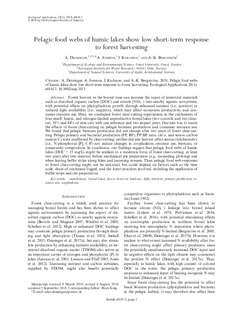| dc.description.abstract | Forest harvest in the boreal zone can increase the input of terrestrial materials such as dissolved organic carbon (DOC) and nitrate (NO3) into nearby aquatic ecosystems,with potential effects on phytoplankton growth through enhanced nutrient (i.e., positive) or reduced light availability (i.e., negative), which may affect ecosystem productivity and consumer resource use. Here, we conducted forest clear-cutting experiments in the catchments of four small, humic, and nitrogen-limited unproductive boreal lakes (two controls and two clear-cut, 18% and 44% of area cut) with one reference and two impact years. Our aim was to assess the effects of forest clear-cutting on pelagic biomass production and consumer resource use.We found that pelagic biomass production did not change after two years of forest clear-cut-ting: Pelagic primary and bacterial production (PP, BP), PP:BP ratio, chla, and seston carbon(seston C) were unaffected by clear-cutting; neither did tree harvest affect seston stoichiometry(i.e., N:phosphorus [P], C:P) nor induce changes in zooplankton resource use, biomass, or community composition. In conclusion, our findings suggest that pelagic food webs of humic lakes (DOC>15 mg/L) might be resilient to a moderate form of forest clear-cutting, at least two years after tree removal, before mechanical site preparation (e.g., mounding, plowing) and when leaving buffer strips along lakes and incoming streams. Thus, pelagic food web responses to forest clear-cutting might not be universal, but could depend on factors such as the timescale, share of catchment logged, and the forest practices involved, including the application of buffer strips and site preparation. | nb_NO |
